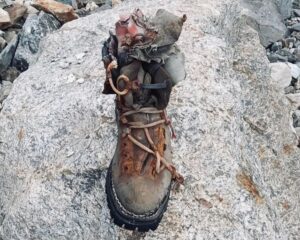Two cemeteries sit at what would have been the northeast corner of the old sanitarium that has gone by many names since it was purchased by the Oklahoma Sanitarium Co. in 1895 (1). Both of these cemeteries contain patients that were housed in the institution, but Rock Creek Road Cemetery is the resting place for the majority of them.
I think that often, we ignore the significance of the areas just beyond our doorstep. We are so used to seeing and experiencing the same things close to home that we become unaware of what is really around us. It is for this reason that I have chosen to explore the history that is right next door… literally. Less than a mile away from my home is the north campus of what was once Central State Hospital, a sanitarium for the “violent insane.” This particular urban expedition caught my attention not only because the campus is six city blocks of abandoned structures, rubble and wilderness, but because of the fascinating stories that it holds.
The Rock Creek Road Cemetery was established in 1933 for the purpose of accommodating the graves of deceased patients. As the sanitarium has existed since the early 1900’s, it is unclear where the deceased were buried prior to this date. Some have speculate that they were buried directly on sanitarium grounds. I will make a point to look for evidence of this claim upon future visits to the central block of the campus. Not much else is known about the cemetery itself except that it contains a few hundred graves. The markers are all simple concrete blocks with engraved information and no decorative elements.
It was unfortunate to see that some of the markers were missing information. I thought about the lives those particular patients must have led, unable to recall or communicate their own date of birth, and no family to provide that information to hospital administration. It almost compounds the tragic loss of identity that comes with forfeiting your place in society, as one would upon being admitted to such an institution. However, conservation buffs and genealogists have stepped in to ensure that the names and locations of the deceased are properly logged and available for anyone who wishes to find them.
The second cemetery, which is actually a combination of the Independent Order of Odd Fellows (IOOF) Cemetery and the more modern St. Joseph’s Catholic Cemetery, is located just to the west of Rock Creek Road Cemetery. This cemetery was established in 1891, four years before the Oklahoma Sanitarium Company, although it seems that it was not used for sanitarium patients –possibly to maintain the separation of patients and regular members of society(2).
However, an exceptionally interesting component of IOOF Cemetery is the presence of a mass grave, which contains the remains of 39 of the 40 victims of “the worst fire in Oklahoma history” (3) as measured by death toll. The fire started in the linen closet of residential ward 14 and spread to engulf wards 10, 15, and the central dining hall, which were all wooden structures. Most of the patients and employees escaped the fire, but the 40 men and boys in ward 14, known today as “The Unfortunates” were not so lucky.
Up until April of this year, the site of the mass grave had no marker. Red flags outlined the 13′ x 16′ plot where the Oklahoma Archaeological Survey determined the grave to be. This is what I spent an hour and a half looking for last week, while passing by the shiny new granite headstone multiple times. It was worth the frustration and extra research though, to finally see the large marker with the 39 names engraved on it. For almost 100 years, these names had been lost, but hospital staff worked diligently to track down the families of The Unfortunates and ensure that they were not forgotten.
I think there is a valuable lesson in that. Many kinds of people have walked through the doors of Central State Hospital and Griffin Memorial Hospital. People who cannot care for themselves, sick people, violent people, people who are very different from the rest of society. I think it is easy for us to pass judgement on others. I see it happen every day. It is just another way that we try to make sense of the world…a kind of perverse classification method. We do it without thinking. Some people commit acts in their lives that might warrant judgement, some may just be unfortunate victims of misunderstanding. I hope that through exploring the history of Central State Hospital, I can get a better sense of the people who lived and worked there and start to move away from judgement and towards objective cognizance.
The main campus of Griffin Memorial Hospital will soon be demolished and redeveloped, and the main facility will be moved to a new location. This area is a significant part of Norman’s history and its stories should be preserved. While others have documented specific buildings or events, I hope my series of stories and articles will add a bit more context to the work that has already been done.
Notes:
The Hospital has been known as Norman State Hospital, Norman Institution for the Violent Insane, Central State Hospital, and Griffin Memorial Hospital
This is speculation derived from the fact that IOOF Cemetery was established before Rock Creek Road Cemetery, yet the only people buried there associated with the sanitarium campus were the 1918 fire victims.
While this article states that the fire claimed 38 victims, an article by a local news source claims that the hospital records put the official number of victims at 40.
All Images copyright: Catherine Carter 2015





